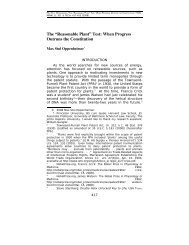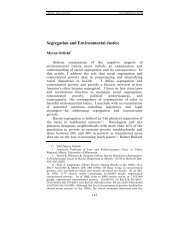An Organizational Approach to the Design of Patent Law
An Organizational Approach to the Design of Patent Law
An Organizational Approach to the Design of Patent Law
You also want an ePaper? Increase the reach of your titles
YUMPU automatically turns print PDFs into web optimized ePapers that Google loves.
6 VERTINSKY FINAL_JAD (DO NOT DELETE) 2/27/2012 2:20 PM<br />
2012] AN ORGANIZATIONAL APPROACH 247<br />
The “new property rights” literature centers around <strong>the</strong><br />
idea that property rights become important where contracts are<br />
incomplete or o<strong>the</strong>rwise difficult <strong>to</strong> enforce, ei<strong>the</strong>r because <strong>of</strong><br />
unforeseen contingencies, costs <strong>of</strong> writing contracts, or costs <strong>of</strong><br />
enforcement. 164 In <strong>the</strong>se cases, as illustrated by pioneers <strong>of</strong> <strong>the</strong><br />
approach such as Oliver Hart, ownership <strong>of</strong> <strong>the</strong> underlying assets<br />
becomes critical in determining <strong>the</strong> level <strong>of</strong> investment in<br />
and <strong>the</strong> allocation <strong>of</strong> benefits from <strong>the</strong> assets. 165 This incomplete<br />
contracting approach has been usefully applied <strong>to</strong> explain<br />
observed patterns <strong>of</strong> ownership over patents, such as why firms<br />
contracting for research and development services might assign<br />
resulting patent rights <strong>to</strong> <strong>the</strong> firm providing <strong>the</strong> services. 166<br />
Critical questions for contemporary patent policy include how<br />
patents can be used <strong>to</strong> address challenges <strong>of</strong> team production<br />
and collaboration between different organizations, particularly<br />
public-private partnerships. 167<br />
The organizational approach provides a <strong>the</strong>oretical underpinning<br />
for many property rights-based proposals for patent reform,<br />
as described fur<strong>the</strong>r in Part IV, by explaining when and<br />
why <strong>the</strong> predictability and allocation <strong>of</strong> property rights over inventions<br />
matters. It also anchors competing models, including<br />
those based on incomplete contracts, property rights, and<br />
transaction costs, in a larger framework that can accommodate<br />
164. See discussion <strong>of</strong> new property rights in Merges, supra note 15, at<br />
1484–85 (discussing that <strong>the</strong> New Property Rights approach was pioneered by<br />
Oliver Hart, Sanford J. Grossman, and John Moore). See generally Sanford J.<br />
Grossman & Oliver D. Hart, The Costs and Benefits <strong>of</strong> Ownership: A Theory <strong>of</strong><br />
Vertical and Lateral Integration, 94 J. POL. ECON. 691, 716 (1986); Oliver Hart<br />
& John Moore, Property Rights and <strong>the</strong> Nature <strong>of</strong> <strong>the</strong> Firm, 98 J. POL. ECON.<br />
1119, 1121–25 (1990) (assessing <strong>the</strong> different costs <strong>of</strong> transactions carried out<br />
within a firm and those carried out through <strong>the</strong> market).<br />
165. See Oliver Hart & John Moore, Foundations <strong>of</strong> Incomplete Contracts,<br />
66 REV. ECON. STUD. 115, 132–35 (1999); Jean Tirole, Incomplete Contracts:<br />
Where Do We Stand? 67 ECONOMETRICA 741, 743–44 (1999) (examining how<br />
incomplete contracts literature can help us <strong>to</strong> understand economic phenomena<br />
such as <strong>the</strong> patent system, and taking s<strong>to</strong>ck <strong>of</strong> <strong>the</strong> strengths and limits <strong>of</strong><br />
<strong>the</strong> literature).<br />
166. See Merges, supra note 15, at 1484–85, for discussion <strong>of</strong> <strong>the</strong> New<br />
Property Rights approach and o<strong>the</strong>r examples. See also Ashish Arora & Robert<br />
P. Merges, Specialized Supply Firms, Property Rights, and Firm Boundaries,<br />
13 INDUS. & CORP. CHANGE 451, 460–70 (2004); Philippe Aghion & Jean<br />
Tirole, The Management <strong>of</strong> Innovation, 109 Q.J. ECON. 1185, 1189–97 (1994).<br />
167. See e.g., ROCHELLE DREYFUSS, Commodifying Collaborative Research,<br />
in THE COMMODIFICATION OF INFORMATION, (Neil Netanel & Neva<br />
Elkin Koran, eds., 2002) (examines challenges that commodification <strong>of</strong> ideas<br />
via patent rights creates for collaborative projects and <strong>the</strong> need <strong>to</strong> refine patent<br />
laws <strong>to</strong> address increasingly team based discovery).






